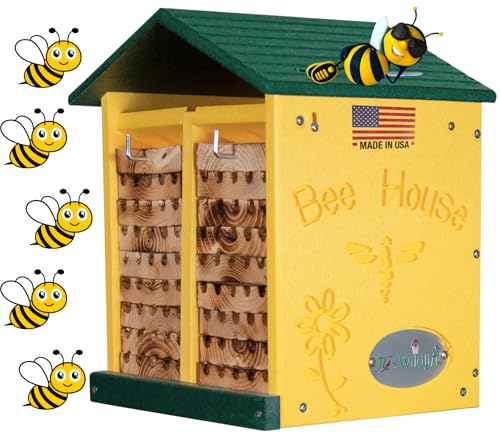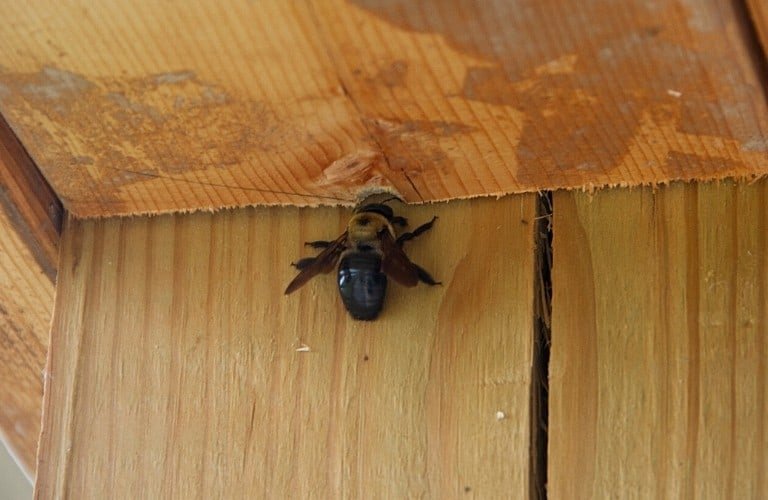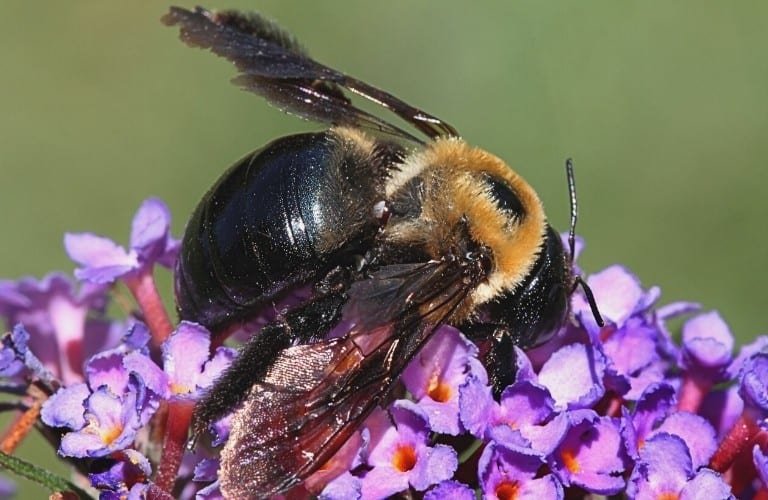Carpenter bees are considered to be pests. But wait – don’t people advocate for saving the bees?
There seems to be some confusion about how to treat these wood-boring bees, so it’s best to make decisions based on their population statistics.
Are carpenter bees endangered? Although they are not yet endangered, like other bees native to North America, carpenter bee populations are steadily declining due largely to loss of habitat and food sources, pesticide use, invasive species, and general lack of concern for their welfare.
In the following you’ll learn more about how carpenter bees can be helpful or problematic and bee-friendly ways you can deal with them if they become pests.
What Are Native Bees?
Native bees are the bees that weren’t introduced to the area. North America has about 4,000 native species of bees which fall under these types:
- Carpenter bees.
- Miner bees.
- Hole nester bees.
- Foraging bees.
These bees have always been around and are crucial for the success of many plants. In fact, most pollination is done by native bees.
The typical black and yellow striped honey bees aren’t native to the United States, but they’re used for commercial beekeeping because they’re great at making honey.
They’re a well-known bee, and many “save the bee” efforts go toward the dwindling honey bee population, which causes native bees to get overlooked.
Native bees have a wide range of color variations.
Surprisingly, they aren’t typically black and yellow but can be black, brown, purple, green, and blue.
(Check out the gorgeous blue carpenter bee featured in this article.)
There’s a rainbow of bees buzzing around the United States, and we depend on them to pollinate our flowers and food.
Should I Kill Carpenter Bees?
Carpenter bees are an irritating pest for many homeowners.
Instead of living in a hive or in the ground, they like to drill holes in trees and other wood sources, like your house or fence.
Are Carpenter Bees Really Pests?
The definition of a pest is a bit subjective, especially when it comes to carpenter bees.
One person might not be bothered if a carpenter bee makes their shed their home, while someone else might think it’s the worst kind of problem to have.
But, objectively speaking, are they really pests? Let’s look at some of the things they do that make them seem like a nuisance.
- Drill holes: They don’t eat wood, but they do drill 1/4-inch holes so they can lay their eggs inside of it. They probably won’t be noticeable from afar, and their nests can’t cause structural damage unless it’s a severe infestation.
- Buzz around your face: Male bees protect the nest while the female lays eggs and raises the young. If you go near the nest, the male might buzz around your head to threaten you. The males do not have a stinger, but the females do and may use it if threatened.
- Sawdust piles: When carpenter bees drill holes, they leave piles of sawdust on the ground. It might be annoying to clean up, but sawdust is a good mulch for plants, so you can easily sweep it into a flowerbed.
When they aren’t messing up your property, they’re pollinating flowers. Pollination is what gives us food to eat.
While there are many pollinators roaming the earth, bees play a huge part, and our food sources would diminish significantly without them.
(Be sure to read our article “Are Carpenter Bees Good or Bad?” to discover how helpful carpenter bees can be and if the damage they do is really cause enough to warrant killing them.)
How to Safely Get Rid of Carpenter Bees
The best way to get rid of carpenter bees is to encourage relocation (see our complete guide here).
This won’t eliminate them, but it will at least convince them to build their nests somewhere else.
Bee Houses
Bee houses are an easy way to encourage relocation.
You can build one from wood or purchase one online and set it up somewhere in your yard away from areas where you don’t want them to build.
Ideally, bee houses should be at least 6 inches deep because that’s the size bees build their nests.
A good budget option is the Rivajam Mason Refillable Bee House. It’s deep enough to keep the bees happy and is made with sustainable pine materials.
The overhang on the roof will keep the bees nice and dry, and the 96 nesting tubes are outfitted with replaceable paper liners, so yearly maintenance is simple and easy.
Another good bee house is the JCs Wildlife Double-Wide Bee House.
It’s considerably bigger than the Rivajam Bee House, and it’s 10 inches deep, so bees will enjoy having plenty of space.
The 16 panels each have five predrilled holes and can be removed for yearly cleaning.
To make the bees move out of your home sooner, you can use a lure like Lakota Earthlink Naturals Carpenter Bee Trap Lure to put on the bee house to attract them.
Head over to our article “Best Carpenter Bee Bait” to explore all of your options for safely luring carpenter bees away from your home to a new location.
Natural Repellent
Bees hate the scent of garlic and citrus. You can use garlic powder or citrus essential oils (this set contains three) to make them vacate their nests.
Sprinkle garlic powder around the area or mix several drops of essential oil with water and spray it on the nests.
Be extra careful when doing this, though, as they may feel threatened.
How Can I Save the Bees?
Bees of all kinds are becoming endangered, and a few species have even become extinct in recent years.
Carpenter bees are a bit more susceptible to dwindling populations since native bees are often overlooked because they don’t fit the typical black and yellow look.
Fortunately, there are a couple of simple things you can do to help out if you feel compelled to do so.
Say No to Pesticides
Pesticides are used by farmers and home growers all around the country to get rid of bugs that eat up crops.
Unfortunately, bees get caught in the crossfire and die as they try to pollinate plants.
If you have a pest problem, try using natural methods of elimination and use pesticides as a last resort.
It’s best to call an exterminator if you want to use pesticides because they know how to safely apply them to reduce the number of bees that will be affected.
Many people have been advised to spray WD-40 into carpenter bee nests to kill them. While this method does work, relocation is a better alternative.
Turn Your Yard into a Bee Sanctuary
Urbanization plays a huge part in the decline of native bees.
As farmland is sold off to contractors to build houses and shopping centers, bees lose valuable land and have fewer crops to feed on.
You can provide the bees with a place to live and work by turning your yard into a bee sanctuary.
It doesn’t take much – you could easily turn an apartment balcony into one as well.
Plant a Variety of Flowers
Bees are at their best when there’s a wide variety of flowers to pollinate.
To encourage carpenter and other native bees, plant flowers that are native to your area.
If your local bees can be found in other parts of the country, you’ll have a wider selection to choose from.
Plant Trees
Trees that have blossoms in the spring do wonders for bees. One tree provides hundreds of pollen sources.
The tree also doubles as a bee house since some carpenter bees will make their nest in tree trunks.
Many cities lack trees, so adding a few in your yard can help the local bee population bounce back.
Provide a Bee-Friendly Water Source
Bees drink water too. Provide a shallow water source that bees can comfortably drink from.
If you have a birdbath, place a pile of stones that reaches above the water so the bees can land on it and drink without falling in.
Final Thoughts
Although not critically endangered, carpenter bee populations are slowly decreasing each year.
If you see them building nests in your home, weigh the pros and cons of their presence before you try to kill them.
Providing them a shelter in a different location is a good way to keep them from damaging your property and becoming endangered.
Don’t miss out on more carpenter bee facts and methods for protecting your property without harming the bees.
Click here to view all of our articles on this bulky, beneficial bee.






